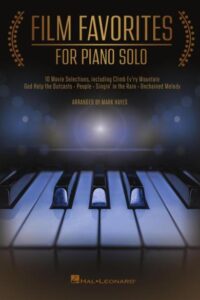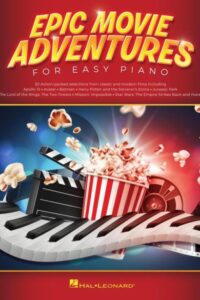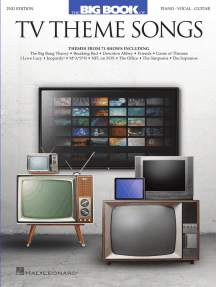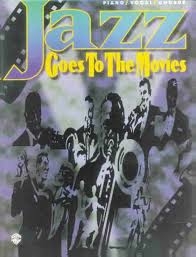Table of Contents
Come join us now, and enjoy playing your beloved music and browse through great scores of every level and styles!
Can’t find the songbook you’re looking for? Please, email us at: sheetmusiclibrarypdf@gmail.com We’d like to help you!
Happy birthday, Lalo Schifrin, born on this day in 1932.

Best Sheet Music download from our Library.
Lalo Schifrin: The Alchemist of Sound – Bridging Jazz, Classical, and the Silver Screen
Few names in 20th and 21st-century music evoke such a potent blend of sophistication, excitement, and genre-defying mastery as Lalo Schifrin. Composer, pianist, conductor, arranger – Schifrin is a true musical polymath whose prolific output spans iconic film and television scores, groundbreaking jazz compositions, ambitious classical works, and everything in between. His unique sonic fingerprint, characterized by driving rhythms, complex harmonies, and an uncanny ability to capture narrative tension and cool, has left an indelible mark on global culture. This article delves deep into the life, style, techniques, and enduring legacy of this extraordinary artist.

Please, subscribe to our Library.
If you are already a subscriber, please, check our NEW SCORES’ page every month for new sheet music. THANK YOU!
I. Biography: From Buenos Aires to Global Icon
Born Boris Claudio Schifrin on June 21, 1932, in Buenos Aires, Argentina, Lalo Schifrin was immersed in music from infancy. His father, Luis Schifrin, was the concertmaster of the Teatro Colón Philharmonic Orchestra, exposing young Lalo to the pinnacle of European classical repertoire. He began formal piano studies at age six and entered the Paris Conservatoire at 16, where he studied classical piano and composition. However, the vibrant cultural life of post-war Paris also ignited his passion for jazz. He spent nights absorbing the sounds of bebop pioneers like Dizzy Gillespie and Charlie Parker in the city’s legendary clubs.
Returning to Buenos Aires in the early 1950s, Schifrin became a pivotal figure in the burgeoning Argentine jazz scene. He formed his own big band, embracing the complex harmonies and rhythmic innovations of modern jazz while incorporating elements of Argentine tango and folk music – a fusion that would become a hallmark of his style. His reputation grew rapidly, catching the attention of international stars touring Argentina, most significantly Dizzy Gillespie in 1956. Gillespie was so impressed he invited Schifrin to join his band in the United States as pianist and arranger.
Schifrin moved to New York City in 1958, plunging into the heart of the jazz world. He arranged Gillespie’s ambitious “Gillespiana” suite (1960) and composed “The New Continent” (1962), showcasing his ability to write large-scale, orchestrated jazz works. His talents as a pianist were also in high demand, leading to recordings and performances with legends like Sarah Vaughan, Ella Fitzgerald, Count Basie, Stan Getz, and Maynard Ferguson.

Contents List Download:
Browse in the Library:
Or browse in the categories menus & download the Library Catalog PDF:

The 1960s marked Schifrin’s pivotal transition into film and television scoring. His first major break came composing the theme for the popular TV series The Man from U.N.C.L.E. (1964-1968). Its infectious, spy-jazz vibe immediately established his knack for creating memorable, zeitgeist-capturing themes. This success led to his first significant film score for Rhino! (1964), but it was his collaboration with director Don Siegel on The Killers (1964) that truly showcased his dramatic potential. However, it was 1966 that cemented his legend:
- Mission: Impossible (TV Series): Schifrin composed arguably the most recognizable television theme in history. Built around a driving 5/4 rhythm (highly unusual for pop culture at the time), a sinuous, instantly hummable bass line, and piercing trumpet and flute figures, the theme perfectly encapsulated danger, intrigue, and sophisticated cool. Its influence is immeasurable.
- Mannix (TV Series): Another iconic theme, blending jazz, suspense, and a touch of melancholy, featuring a memorable flugelhorn melody over propulsive rhythms and lush strings.
- Cool Hand Luke: His score masterfully blended bluesy harmonica (played by Tommy Morgan), gospel choirs, and orchestral tension to underscore Paul Newman’s iconic performance, creating a uniquely American soundscape of resilience and defiance.
From this point, Schifrin became one of Hollywood’s most sought-after composers. He forged defining partnerships with directors like Don Siegel (Dirty Harry, Charley Varrick, The Beguiled), Stuart Rosenberg (Cool Hand Luke, Voyage of the Damned), and Clint Eastwood (Coogan’s Bluff, The Beguiled, Joe Kidd, Escape from Alcatraz). His score for Bullitt (1968) is legendary, particularly the car chase sequence, where his use of ostinato bass lines, modal jazz horns, and percussive drive created an unparalleled sense of kinetic energy and cool menace.

Schifrin never abandoned his jazz roots, continuing to record acclaimed albums like Marquis de Sade (1966), There’s a Whole Lalo Schifrin Goin’ On (1968), and collaborations with Dizzy Gillespie and others. He also pursued serious classical composition, writing concertos, orchestral works, and even a cantata based on the writings of Martin Luther King Jr.
Awarded six Grammy Awards (with twenty-two nominations) and four Oscar nominations, Schifrin remained remarkably active well into his 80s and 90s, conducting major orchestras worldwide and composing new works. He passed away peacefully in Los Angeles on July 16, 2024, leaving behind an unparalleled musical legacy.
II. Music Style: The Schifrin Synthesis
Lalo Schifrin’s style is a breathtaking synthesis, a unique alchemy of diverse elements:
- Jazz Foundation: Bebop’s harmonic sophistication and rhythmic drive are the bedrock. He utilized extended chords, complex substitutions, and virtuosic improvisation (both in his writing and piano playing). The feel and phrasing of jazz permeate even his most orchestral works.
- Classical Mastery: His rigorous training is evident in his masterful orchestration, contrapuntal techniques, thematic development, and structural sophistication. He could write with the grandeur and complexity of a Stravinsky or Bartók when the context demanded.
- Latin Rhythmic Vitality: His Argentine heritage infused his music with infectious Latin rhythms – tango, milonga, bossa nova, Afro-Cuban patterns (montunos, mambos, cha-cha-chás). This rhythmic energy, often layered and complex, is a defining characteristic, providing relentless propulsion and exotic color.
- Film Noir & Suspense Sensibility: Schifrin possessed an innate understanding of how music could amplify tension, mystery, and danger. He employed dissonance, unusual instrumental combinations (vibraphone, harpsichord, electric bass, flutes), angular melodies, and sudden dynamic shifts to create palpable unease. Think Dirty Harry‘s chilling main title or the suspense cues in Mission: Impossible.
- “Cool” Aesthetic: Schifrin defined the sound of 60s and 70s cinematic “cool.” This involved sleek, often minor-key melodies, sophisticated jazz harmonies, prominent use of instruments like flugelhorn, vibraphone, Fender Rhodes, and electric bass, and a sense of urban detachment blended with underlying intensity (e.g., Bullitt, Mannix, Coogan’s Bluff).
- Eclecticism & Fusion: He fearlessly blended genres within a single score or even a single cue. A chase scene might fuse big band jazz with driving rock rhythms and avant-garde orchestral clusters. A love theme might incorporate bossa nova with lush strings and impressionistic harmonies.

III. Improvisational Licks and Techniques (The Jazz Soul)
While primarily known as a composer, Schifrin was a formidable jazz pianist. His improvisational style reflected his compositional brain – harmonically rich, rhythmically complex, and often incorporating classical motifs or Latin feels. Analyzing specific licks requires transcriptions, but key characteristics permeate his playing and writing for soloists:
- Bebop Vocabulary: Rapid-fire eighth-note lines utilizing scales like altered dominants, diminished, whole-tone, and melodic minor modes over complex chord changes. Chromatic approaches and enclosures were common.
- Modal Fluidity: Especially in his own compositions, Schifrin soloed effectively over modal vamps (like the famous Mission: Impossible bassline in E Dorian). His lines would emphasize the mode’s characteristic notes while weaving in chromatic passing tones and bebop embellishments.
- Latin Phrasing: When playing over Latin grooves, his lines incorporated rhythmic syncopations and phrasing idiomatic to mambo, bossa, or tango, sometimes using pentatonic or blues scales adapted to the rhythmic context.
- Harmonic Sophistication: His solos often featured “outside” playing – superimposing triads or scales from distant keys over the underlying harmony, creating tension resolved through voice leading. He frequently used quartal harmony (chords built in 4ths) in his comping and solo lines, lending a modern, open sound.
- Motivic Development: Like a classical composer, Schifrin would sometimes develop short melodic motifs throughout an improvisation, creating cohesion and logic.
IV. Chord Progressions and Music Harmony: The Architectural Genius
Schifrin’s harmonic language is one of his most distinctive and sophisticated features. He moved far beyond simple diatonic progressions:
- Extended & Altered Chords: Dominant 7ths were just the starting point. He liberally used 9ths, 11ths, 13ths, altered dominants (b9, #9, #11, b13), minor-major 7ths, half-diminished, and fully diminished chords. This created rich, complex, often ambiguous sonorities. (e.g., The opening cluster chord of Mission: Impossible).
- Chromatic Harmony & Side-Stepping: Schifrin frequently employed chromatic chord movements, moving chords by half-step or whole-step outside the immediate key center for dramatic or unsettling effect. This is prominent in his suspense cues.
- Modal Interchange (Borrowed Chords): He freely borrowed chords from parallel minor or major scales (e.g., using a iv chord from minor in a major key progression), adding color and unexpected twists. Cool Hand Luke‘s main theme uses this beautifully.
- Tritone Substitution: A staple of jazz harmony, replacing a dominant chord with another dominant chord a tritone away (e.g., substituting Db7 for G7). Schifrin used this for smooth voice leading and heightened tension/resolution. Listen to the bridge sections in many of his jazz compositions.
- Polytonality & Bitonality: Occasionally layering two different keys or harmonies simultaneously for dissonance and complexity, especially in climactic or psychologically intense moments (The Beguiled, some Dirty Harry cues).
- Ostinato Bass Patterns: A Schifrin trademark. Complex, often syncopated bass lines (acoustic or electric) repeating under shifting harmonies above. This provided relentless drive and a foundation for harmonic exploration. The Bullitt car chase and Mission: Impossible theme are prime examples.
- Planing: Moving a chord shape (often quartal or cluster) up or down in parallel motion, creating a shimmering, sometimes unsettling effect. Used effectively for transitions or mysterious atmospheres.
V. Influences: A Tapestry of Sound
Schifrin’s vast musical tapestry was woven from countless threads:
- Classical: Igor Stravinsky (rhythmic drive, dissonance, orchestral brilliance), Béla Bartók (folk influences, complex rhythms, “night music”), Maurice Ravel (orchestral color, impressionistic harmony), Claude Debussy, Alberto Ginastera (his teacher, incorporating Argentine elements).
- Jazz: Dizzy Gillespie (mentor, bebop, Afro-Cuban fusion), Thelonious Monk (angular melodies, dissonance), Charlie Parker (bebop language), Duke Ellington (orchestration, tone colors), John Coltrane (modal exploration, intensity), Miles Davis (cool aesthetic, modal jazz).
- Latin/Tango: Astor Piazzolla (modern tango revolution), traditional Argentine tango and folk (rhythms, melodic sensibility), Afro-Cuban music (mambo, cha-cha-chá).
- Film Composers: Bernard Herrmann (psychological tension, innovative orchestration), Alex North (jazz-infused scores), Henry Mancini (cool jazz/pop sensibility), Jerry Goldsmith (dramatic intensity, orchestral mastery).
- Argentine Folk & Popular Music: The rhythms and melodic contours of his homeland were always present beneath the surface.
VI. Legacy: The Enduring Resonance
Lalo Schifrin’s legacy is monumental and multifaceted:
- Defining the Sound of an Era: His themes for Mission: Impossible, Mannix, Cool Hand Luke, Bullitt, and Dirty Harry are cultural touchstones, instantly evoking the style, suspense, and cool of the 1960s and 70s.
- Elevating Film & TV Music: He brought unprecedented levels of jazz sophistication, complex harmony, and rhythmic innovation to mainstream Hollywood scoring, proving that “genre” music could be artistically ambitious and dramatically powerful. He influenced generations of film composers (e.g., John Carpenter, Danny Elfman, Hans Zimmer in his jazzier moments).
- Jazz-Classical Fusion Pioneer: Works like Gillespiana, The New Continent, and his later concertos demonstrated the viability and richness of merging large-scale classical forms with the improvisational spirit and harmonic language of jazz.
- Master of Genre-Blending: He showed that diverse musical elements – jazz, classical, Latin, rock, avant-garde – could coexist and enhance each other powerfully within a single musical vision, paving the way for later fusion movements.
- The Quintessential “Cool”: His sound became synonymous with sophisticated, urban, slightly dangerous cool, influencing not just music but broader pop culture aesthetics.
- Technical Brilliance: His command of orchestration, counterpoint, harmony, and rhythm remains a benchmark for composers across all genres.
- Global Ambassador: As an Argentine-born artist achieving global success, he represented a bridge between cultures, incorporating Latin elements into the mainstream of American music.
VII. Major Works & Filmography (Selective)
Schifrin’s output is staggering. Here’s a glimpse:
- Iconic Themes: Mission: Impossible (TV/Film), Mannix, Cool Hand Luke, Bullitt, Dirty Harry, Starsky & Hutch (TV), Rush Hour (Film Series – later adaptation of his style).
- Landmark Film Scores: The Cincinnati Kid (1965), The Fox (1967), Coogan’s Bluff (1968), Hell in the Pacific (1968), Kelly’s Heroes (1970), The Beguiled (1971), Charley Varrick (1973), Enter the Dragon (1973), The Four Musketeers (1974), Voyage of the Damned (1976), The Eagle Has Landed (1976), The Amityville Horror (1979), Escape from Alcatraz (1979), The Sting II (1983), The Dead Pool (1988), Tango (1998).
- Major Jazz Compositions/Albums: Gillespiana (1960), The New Continent (1962), Piano, Strings and Bossa Nova (1962), Samba Para Dos (w/ Bob Brookmeyer, 1963), Marquis de Sade (1966), There’s a Whole Lalo Schifrin Goin’ On (1968), Rock Requiem (1971), Black Widow (1976), Gypsies (1980), Esperanto (2000).
- Significant Classical Works: Concerto for Double Bass (Concierto de la Amistad – w/ Gary Karr), Cantos Aztecas, Pulsations for Orchestra, Jazz Mass, Concerto for Guitar and Orchestra “Cantos Andinos”, Symphonic Impressions of Oman.
VIII. Discography (Highly Selective – Focus on Key Albums)
- Early Jazz/Arranger: Gillespiana (Dizzy Gillespie, 1960), The New Continent (1962), Bossa Nova: New Brazilian Jazz (1962), Piano, Strings and Bossa Nova (1962), Samba Para Dos (w/ Bob Brookmeyer, 1963).
- Defining 60s Sound: Once a Thief and Other Themes (1965), The Liquidator (1966), Marquis de Sade (1966), Mission: Impossible (Original TV Soundtrack, 1967), Mannix (Original TV Soundtrack, 1968), There’s a Whole Lalo Schifrin Goin’ On (1968), Bullitt (Original Soundtrack, 1968), Che! (Original Soundtrack, 1969).
- 70s Exploration: Rock Requiem (1971), Dirty Harry (Original Soundtrack, 1971), Enter the Dragon (Original Soundtrack, 1973), The Four Musketeers (Original Soundtrack, 1974), Voyage of the Damned (Original Soundtrack, 1976), Black Widow (1976), Rollercoaster (Original Soundtrack, 1977).
- Later Highlights: Gypsies (1980), Ins and Outs (1982), Jazz Mass (Recorded 1998), Esperanto (2000), Letters from Argentina (2000), Lalo Schifrin: Jazz Meets the Symphony Collection (Multiple Volumes, 1990s-2000s), Schifrin/Saint-Saëns: The Carnival of the Animals (2005).
IX. Most Known Works and Performances: The Cultural Imprint
- Mission: Impossible Theme (TV): Transcended television to become a global cultural icon, endlessly covered, sampled, and referenced. Its 5/4 rhythm is instantly recognizable.
- Bullitt (Main Title & Car Chase Music): Synonymous with cinematic car chases. Its driving jazz-rock energy, modal horns, and relentless bass ostinato created a template for action scoring.
- Dirty Harry (Main Title): A masterpiece of suspense and menace. The chilling combination of vibraphone, electric bass, dissonant strings, and that unforgettable, ominous three-note motif defined the character and the gritty realism of the film.
- Cool Hand Luke (Score & Theme): Perfectly captured the film’s blend of Southern gothic, existential struggle, and dark humor. The harmonica theme (“Plastic Jesus” adaptation) is hauntingly beautiful, while the chain gang work cues are powerfully rhythmic and oppressive.
- Mannix Theme: Epitomized the cool, sophisticated, yet slightly melancholic sound of 70s detective TV.
- “The Cat” (from the album There’s a Whole Lalo Schifrin Goin’ On): A funky, big band jazz classic, widely sampled in hip-hop, showcasing his writing for large ensembles.
- Gillespiana Suite (with Dizzy Gillespie): A landmark work demonstrating the successful fusion of large-scale orchestral writing with virtuosic big band jazz and bebop improvisation.
- Enter the Dragon (Main Title & Fight Cues): Effectively blended funk, jazz, and traditional Chinese elements to create a unique atmosphere for the martial arts classic.
- Jazz Mass: A significant late-career work demonstrating his continued ambition to merge jazz idioms with sacred classical forms.
Lalo Schifrin: The Alchemist’s Enduring Gold
Lalo Schifrin was more than just a composer; he was an alchemist of sound. He possessed the rare ability to transform diverse musical elements – the intricate harmony of jazz, the structural rigor of classical music, the visceral energy of Latin rhythms, the narrative power of film scoring – into a unique and universally compelling alloy. His music could be thrillingly complex yet instantly accessible, profoundly sophisticated yet undeniably cool.
From the nerve-jangling suspense of Dirty Harry to the globe-trotting intrigue of Mission: Impossible, from the funky grooves of “The Cat” to the sacred spaces of his Jazz Mass, Schifrin’s vast output consistently displayed brilliance, innovation, and an unwavering commitment to musical excellence. He didn’t just score films and TV shows; he defined eras, shaped genres, and created sonic worlds that continue to resonate powerfully.
Lalo Schifrin’s legacy is the sound of modern musical storytelling itself – adventurous, intelligent, and forever cool. His music remains not just a reflection of the times he lived in, but a timeless testament to the power of fearless creativity and boundless musical imagination.
Lalo Schifrin : Mission Impossible (Final)
Sylvain Gontard, Pierre Boussaguet, François Laizeau, Jean Michel Bernard et l’Orchestre Philharmonique de Radio France interprètent le Final extrait de Mission Impossible de Lalo Schifrin dirigé par Victor Jacob.
Lalo Schifrin : Bullitt
Lalo Schifrin discography.
Filmography
Awards and nominations
Browse in the Library:
Or browse in the categories menus & download the Library Catalog PDF:
Lalo Schifrin – Lalo Schifrin Plays Exotic Piano & Jazzy Latin Melodies – Mam Bop et Bolero
Tracklist: 00:00 – My Man 03:33 – Mambop 06:29 – Caravan 09:42 – Maria 12:10 – Parrot Samba 14:11 – A Time for Love 16:36 – You and Me 18:21 – Warsaw Concerto 20:20 – Hullabalues 23:28 – Cabello Rojo 26:29 – Serenade 29:16 – Little Brown Boy 31:43 – Rapaz de Bem 34:15 – One Note Samba 37:58 – Rio After Dark 40:31 – Capricho Espanol.
